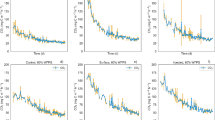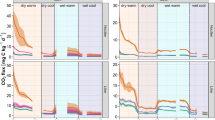Abstract
We assessed the effect of liming on (1) N2O production by denitrification under aerobic conditions using the 15N tracer method (experiment 1); and (2) the reduction of N2O to N2 under anaerobic conditions using the acetylene inhibition method (experiment 2). A Mollic Andosol with three lime treatments (unlimed soil, 4 and 20 mg CaCO3 kg−1) was incubated at 15 and 25 °C for 22 days at 50% and then 80% WFPS with or without 200 mg N kg−1 added as 15N enriched KNO3 in experiment 1. In experiment 2, the limed and unlimed soils were incubated under completely anaerobic conditions for 44 h (with or without 100 mg N kg−1 as KNO3). In experiment 1, limed treatments increased N2O fluxes at 50% WFPS but decreased these fluxes at 80% WFPS. At 25 °C, cumulative N2O and 15N2O emissions in the high lime treatment were the lowest (with at least 30% less 15N2O and total N2O than the unlimed soil). Under anaerobic conditions, the high lime treatment showed at least 50% less N2O than the unlimed treatment at both temperatures with or without KNO3 addition but showed enhanced N2 production. Our results suggest that the positive effect of liming on the mitigation of N2O evolution from soil was influenced by soil temperature and moisture conditions.






Similar content being viewed by others
References
Baggs EM, Smales CL, Bateman EJ (2010) Changing pH shifts the microbial source as well as the magnitude of N2O emission from soil. Biol Fertil Soils 46:793–805. doi:10.1007/s00374-010-0484-6
Bakken LR, Bergaust L, Liu B, Frostegård A (2012) Regulation of denitrification at the cellular level: a clue to the understanding of N2O emissions from soils. Philos Trans R Soc Lond Ser B Biol Sci 367:1226–1234. doi:10.1098/rstb.2011.0321
Bhatia A, Sasmal S, Jain N, Pathak H, Kumar R, Singh A (2010) Mitigating nitrous oxide emission from soil under conventional and no-tillage in wheat using nitrification inhibitors. Agric Ecosyst Environ 136:247–253. doi:10.1016/j.agee.2010.01.004
Bolleter WT, Bushman CJ, Tidwell PW (1961) Spectrophotometric determination of ammonia as indophenol. Anal Chem:592–594
Bonnett SAF, Blackwell MSA, Leah R, Cook V, O’Connor M, Maltby E (2013) Temperature response of denitrification rate and greenhouse gas production in agricultural river marginal wetland soils. Geobiology 11:252–267. doi:10.1111/gbi.12032
Brumme R, Beese F (1992) Effects of liming and nitrogen-fertilization on emissions of CO2 and N2O from a temperate forest. J Geophys Res 97:12851–12858
Clough TJ, Kelliher FM, Sherlock RR, Ford CD (2004) Lime and soil moisture effects on nitrous oxide emissions from a urine patch. Soil Sci Soc Am J 68:1600–1609. doi:10.2136/sssaj2004.1600
Clough TJ, Sherlock RR, Kelliher FM (2003) Can liming mitigate N2O fluxes from a urine-amended soil? Aust J Soil Res 41:439–457. doi:10.1071/SR02079
Davidson EA, Matson PA, Vitousek PM, Riley R, Dunkin K, García- Méndez G, Maass JM (1993) Processes regulating soil emissions of NO and N2O in a seasonally dry tropical forest. Ecology 74:130–139
Dorland S, Beauchamp EG (1991) Denitrification and ammonification at low soil temperatures. Can J Soil Sci 71:293–303. doi:10.4141/cjss91-029
Edmeades DC, Judd M, Sarathchandra SU (1981) The effect of lime on nitrogen mineralization as measured by grass growth. Plant Soil 60:177–186. doi:10.1007/BF02374102
Firestone MK, Davidson EA (1989) Microbiological basis of NO and N2O production and consumption in soil. In: Andreae M, Schimel D (eds) Exchange of trace gases between terrestrial ecosystems ans the atmosphere. John Wiley and Sons, New York, pp 7–21
García-Marco S, Abalos D, Espejo R, Vallejo A, Mariscal-sancho I (2016) No tillage and liming reduce greenhouse gas emissions from poorly drained agricultural soils in Mediterranean regions. Sci Total Environ 566–567:512–520. doi:10.1016/j.scitotenv.2016.05.117
Groffman PM, Altabet MA, Böhlke JK, Butterbach-Bahl K, David MB, Firestone MK, Giblin AE, Kana TM, Nielsen LP, Voytek MA (2006) Methods for measuring denitrification: diverse approaches to a difficult problem. Ecol Appl 16:1267–1276. doi:10.1890/1051-0761(2006)016
IPCC (2014) Climate change 2014: synthesis report. Contribution of working groups I. II and III to the Fifth Assessment Report of the Intergovernmental Panel on Climate Change, Geneva
IUSS Working Group WRB (2006) World Reference Base for soil resources. World soil resources report no. 103. FAO, Rome, Italy
Li L, Wang M, Hatano R, Hashidoko Y (2014) Effects of methyl viologen dichloride and other chemicals on nitrous oxide (N2O) emission and repression by pseudomonad denitrifiers isolated from corn farmland soil in Hokkaido, Japan. J Pestic Sci 39:115–120. doi:10.1584/jpestics.D14-003
Liu R, Hayden HL, Suter H, Hu H, Lam SK, He J, Mele PM, Chen D (2017) The effect of temperature and moisture on the source of N2O and contributions from ammonia oxidizers in an agricultural soil. Biol Fertil Soils 53:141–152. doi:10.1007/s00374-016-1167-8
McMillan AMS, Pal P, Phillips RL, Palmada T, Berben PH, Jha N, Saggar S, Luo J (2016) Can pH amendments in grazed pastures help reduce N2O emissions from denitrification?—The effects of liming and urine addition on the completion of denitrification in fluvial and volcanic soils. Soil Biol Biochem 93:90–104. doi:10.1016/j.soilbio.2015.10.013
Mørkved PT, Dörsch P, Bakken LR (2007) The N2O product ratio of nitrification and its dependence on long-term changes in soil pH. Soil Biol Biochem 39:2048–2057. doi:10.1016/j.soilbio.2007.03.006
Mukumbuta I, Shimizu M, Hatano R (2017a) Mitigating global warming potential and greenhouse gas intensities by applying composted manure in cornfield: a 3-year field study in an andosol soil. Agriculture 7:13. doi:10.3390/agriculture7020013
Mukumbuta I, Shimizu M, Jin T, Nagatake A, Hata H, Kondo S, Kawai M, Hatano R (2017b) Nitrous and nitric oxide emissions from a cornfield and managed grassland: 11 years of continuous measurement with manure and fertilizer applications, and land-use change. Soil Sci Plant Nutr. doi:10.1080/00380768.2017.1291265
Müller C, Laughlin RJ, Spott O, Rütting T (2014) Quantification of N2O emission pathways via a 15N tracing model. Soil Biol Biochem. doi:10.1016/j.soilbio.2014.01.013
Myrstener M, Jonsson A, Bergström AK (2015) The effects of temperature and resource availability on denitrification and relative N2O production in boreal lake sediments. J Environ Sci 47:82–90. doi:10.1016/j.jes.2016.03.003
Narwal RP (2002) Unique properties of volcanic ash soils. Glob J Environ Res 6:99–112
Nie Y, Li L, Isoda R, Wang M, Hatano R, Hashidoko Y (2016) Physiological and genotypic characteristics of nitrous oxide (N2O)-emitting pseudomonas species isolated from dent corn Andisol farmland in Hokkaido. Japan Microbes Environ doi. doi:10.1264/jsme2.ME15155
Pan Y, Ye L, Ni B-J, Yuan Z (2012) Effect of H2S on N2O reduction and accumulation during denitrification by methanol utilizing denitrifiers. Water Res 47:8408–8415. doi:10.1021/es401632r
Pfenning KS, McMahon PB (1997) Effect of nitrate, organic carbon, and temperature on potential denitrification rates in nitrate-rich riverbed sediments. J Hydrol 187:283–295. doi:10.1016/S0022-1694(96)03052-1
Rochester IJ (2003) Estimating nitrous oxide emissions from flood-irrigated alkaline grey clays. Aust J Soil Res 41:197–206. doi:10.1071/SR02068
Saggar S, Jha N, Deslippe J, Bolan NS, Luo J, Giltrap DL, Kim DG, Zaman M, Tillman RW (2013) Denitrification and N2O: N2 production in temperate grasslands: processes, measurements, modelling and mitigating negative impacts. Sci Total Environ 465:173–195. doi:10.1016/j.scitotenv.2012.11.050
Saleh-Lakha S, Shannon KE, Henderson SL, Goyer C, Trevors JT, Zebarth BJ, Burton DL (2009) Effect of pH and temperature on denitrification gene expression and activity in Pseudomonas mandelii. Appl Environ Microbiol 75:3903–3911. doi:10.1128/AEM.00080-09
Šimek M, Cooper JE (2002) The influence of pH on denitrification: progress towards the understanding of this interaction over the last fifty years. Eur J Soil Sci 53:345–354
Šimek M, Jíšová L, Hopkins DW (2002) What is the so-called optimum pH for denitrification in soil? Soil Biol Biochem 34:1227–1234. doi:10.1016/S0038-0717(02)00059-7
Skiba U, Fowler D, Smith KA (1997) Nitric oxide emissions from agricultural soils in temperate and tropical climates: sources, controls and mitigation options. Nutr Cycl Agroecos 48:139–153. doi:10.1023/A:1009734514983
Soto DX, Koehler G, Hobson KA (2015) Combining denitrifying bacteria and laser spectroscopy for isotopic analyses (δ15N, δ18O) of dissolved nitrate. Anal Chem 150707132815009. doi: 10.1021/acs.analchem.5b01119
Takeda H, Takahashi N, Hatano R, Hashidoko Y (2012) Active N2O emission from bacterial microbiota of Andisol farmland and characterization of some N2O emitters. J Basic Microbiol 52:477–486. doi:10.1002/jobm.201100241
Tiedje JM, Simkins S, Groffman PM (1989) Perspectives on measurement of denitrification in the field including recommended protocols for acetylene based methods. Plant Soil 284:261–284
Uchida Y, Von Rein I, Akiyama H, Yagi K (2013) Contribution of nitrification and denitrification to nitrous oxide emissions in Andosol and from Fluvisol after coated urea application. Soil Sci Plant Nutr 1–10. doi: 10.1080/00380768.2012.708646
UNEP (2013) Drawing down N2O to protect climate and the ozone layer. United Nations Environment Programme (UNEP), Nairobi
Ussiri DAN, Lal R, Jarecki MK (2009) Nitrous oxide and methane emissions from long-term tillage under a continuous corn cropping system in Ohio. Soil Tillage Res 104:247–255. doi:10.1016/j.still.2009.03.001
Wertz S, Goyer C, Zebarth BJ, Burton DL, Tatti E, Chantigny MH, Filion M (2013) Effects of temperatures near the freezing point on N2O emissions, denitrification and on the abundance and structure of nitrifying and denitrifying soil communities. FEMS Microbiol Ecol 83:242–254. doi:10.1111/j.1574-6941.2012.01468.x
Zaman M, Nguyen ML (2010) Effect of lime or zeolite on N2O and N2 emissions from a pastoral soil treated with urine or nitrate-N fertilizer under field conditions. Agric Ecosyst Environ 136:254–261. doi:10.1016/j.agee.2009.12.002
Zaman M, Nguyen ML, Matheson F, Blennerhassett JD, Quin BF (2007) Can soil amendments (zeolite or lime) shift the balance between nitrous oxide and dinitrogen emissions from pasture and wetland soils receiving urine or urea-N? Aust J Soil Res 45:543–553. doi:10.1071/SR07034
Author information
Authors and Affiliations
Corresponding author
Rights and permissions
About this article
Cite this article
Mukumbuta, I., Uchida, Y. & Hatano, R. Evaluating the effect of liming on N2O fluxes from denitrification in an Andosol using the acetylene inhibition and 15N isotope tracer methods. Biol Fertil Soils 54, 71–81 (2018). https://doi.org/10.1007/s00374-017-1239-4
Received:
Revised:
Accepted:
Published:
Issue Date:
DOI: https://doi.org/10.1007/s00374-017-1239-4




